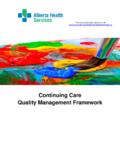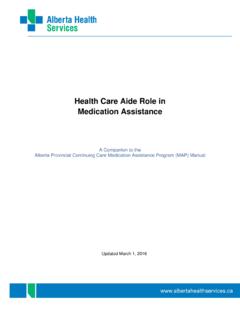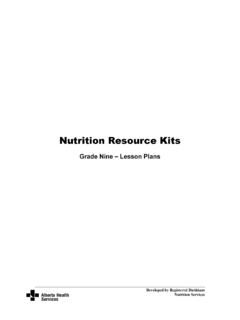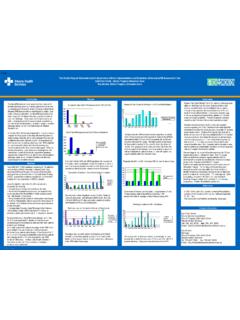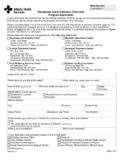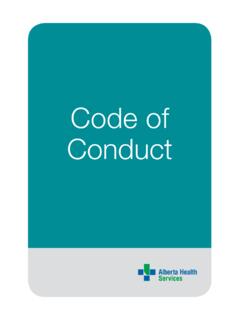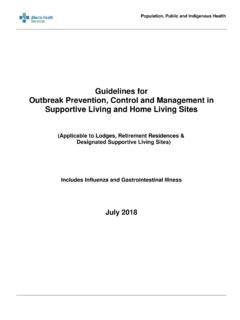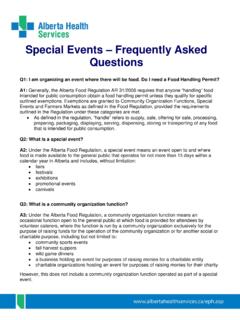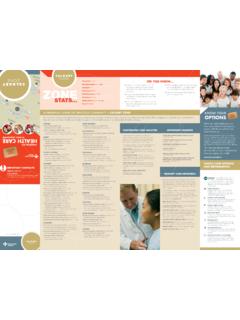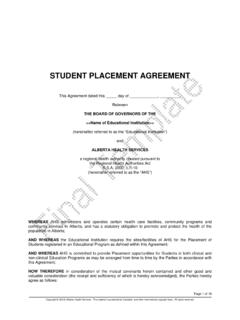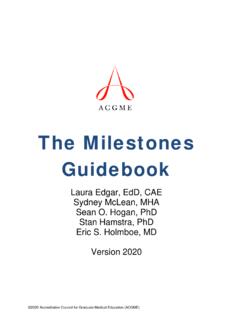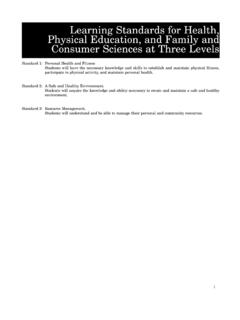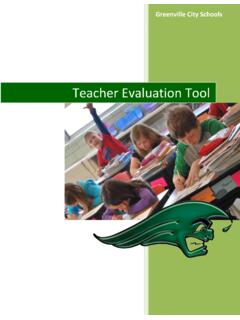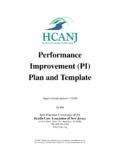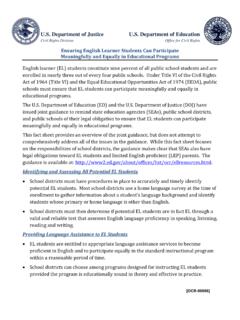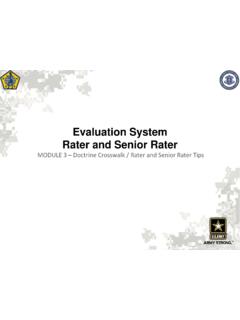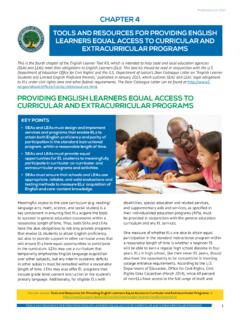Transcription of Comprehensive Assessment - Alberta Health Services
1 1 Comprehensive Assessment Enhancing concurrent capability: A toolkitComprehensive assessmentEnhancing concurrent capability: A toolkit for managers and staffContentsIntroduction ..5 Clinical decision-making: Assessment ..7 Comprehensive Assessment ..9It s not just the tool, it s the process ..12 Interpersonal factors: Engagement ..15 Challenges to factors: A practical approach to Comprehensive to Comprehensive ..46 Appendices1. Content for Comprehensive Assessment ..472. Team activities ..533. Best and promising practices for Comprehensive ..64 Addiction and Mental HealthJune 2016 Copyright (2016) Alberta Health Services . This material is protected by Canadian and other international copyright laws. All rights reserved. This material may not be copied, published, distributed or reproduced in any way in whole or in part without the express written permission of Alberta Health Services (please contact Senior Program Officer at Community, Seniors, Addiction and Mental Health at This material is intended for general information only and is provided on an as is , where is basis.)
2 Although reasonable efforts were made to confirm the accuracy of the information, Alberta Health Services does not make any representation or warranty, express, implied or statutory, as to the accuracy, reliability, completeness, applicability or fitness for a particular purpose of such information. This material is not a substitute for the advice of a qualified Health professional. Alberta Health Services expressly disclaims all liability for the use of these materials, and for any claims, actions, demands or suits arising from such use. 3 Comprehensive Assessment Enhancing concurrent capability: A toolkitTable of ContentsIntroduction ..5 How was this toolkit chapter created? ..5 What you will learn in this chapter ..6 Clinical decision-making: Assessment ..7 Where Assessment fits in.
3 8 Comprehensive Assessment ..9 What is Comprehensive Assessment ? ..9 Benefits of Comprehensive Assessment ..9 You re already assessing ..10 Common s not just the tool, it s the process ..12 The art of Assessment ..13 Information or therapeutic? ..13 The process of Assessment ..14 Interpersonal factors: Engagement ..15 Person-centred ..15 Empathy ..16 Motivation and treatment readiness ..17 Identification of strengths and supports ..19 Cultural sensitivity ..22 Trauma and PTSD ..24 Challenges to engagement ..29 From the pioneers ..29 Accuracy of self-reported use and symptoms ..30 Use of collateral information ..32 Procedural factors: A practical approach to Comprehensive Assessment ..33 Universal access ( no wrong door ) ..33 What to assess ..33 Interaction effects.
4 34 There must be a purpose ..39An ongoing process ..41 Assessment using multiple methods ..42 Challenges to Comprehensive Assessment ..43 From the pioneers ..43 Sorting out the interaction effects ..44 Primary vs. secondary ..44 4 Comprehensive Assessment Enhancing concurrent capability: A toolkitConclusion ..46 Appendix 1: Content for Comprehensive Assessment ..47 Appendix 2: Team activities ..53 Possible content for Comprehensive Assessment : The list ..53 What are you asking for? ..53 The Ds Debate ..54 Social determinants of Health : AMH version ..55 Comprehensive Assessment checklist ..56 Challenges (and solutions) to Comprehensive Assessment ..58 Appendix 3: Best and promising practices for Comprehensive Assessment ..59 Best ..64 5 Comprehensive Assessment Enhancing concurrent capability: A toolkitIntroductionHow was this toolkit chapter created?
5 The content of this chapter is based on a literature review called Assessment of Concurrent Disorders ( Alberta Health Services , 2012) and discussions within Addiction and Mental Health (AMH) to identify the needs regarding Assessment for concurrent disorders. In addition, further research was consulted to identify concrete implementation and practice issues. The Comprehensive Assessment Chapter Subgroup Committee reviewed each draft of this toolkit chapter and provided feedback. We would like to acknowledge the hard work of this committee. Their suggestions and direction have greatly contributed to this are committed to matching the toolkit content to the needs of the people who will be using it. We welcome any feedback, questions, or suggestions for content additions or revisions.
6 We wish to learn from the experiences at the front line, so please let us know how well this toolkit works for you by emailing us at and special thanksComprehensive Assessment Chapter Subgroup MembersDavid M. Gill, Research Assistant, AMHD avid Sinclair, Clinical Consultant, Workforce and Concurrent Capabilities, AMHD onna Kerr, Writer, Kerr CreativeFran Barnes, Manager, Zone Integration, AMHGary P. Anderson, Mental Health Therapist/Consultant, Adult Addictions Services Gillian Hutton, Therapy Specialist, Addiction Centre Calgary Kenneth Doucet, Social Worker, Intake/Crisis Services , Community AMHK rista Warners, Health Promotion Facilitator II, Children, Tertiary & Acute Care, Mental Health Screening/Early Identification, AMHL indsay Victor, Addictions Counsellor, AMHNico Scholten, Clinical Consultant, Workforce and Concurrent Capabilities, AMH (retired)
7 Patricia Chemago, Community Health Addictions Counsellor, AMHPete Kisner, Community Health Addictions Counsellor, AMHR amona Takenaka, Clinical Educator, Community Lead, AMHS haron Mkisi, Provincial Manager, Concurrent Capability, AMH Tanis Duby, Nurse Clinician, AMH Lisa Halma, Manager of Evaluation, Information Management and Planning, AMHT anya Figg, Area Supervisor, Addictions ServicesTammie Efraimson-Hiraga, Mental Health Therapist, Community Support Team, South ZoneVeronica Horn, Shared Care Clinician, Shared Care South ZoneSponsorsBarry Andres, Sr. Director, Performance, Practice & JusticeJill Mitchell, Director, Workforce & Concurrent Capability 6 Comprehensive Assessment Enhancing concurrent capability: A toolkitWhat you will learn in this chapter Instead of having a chapter that focuses on all the different Assessment instruments, we chose to focus on the common processes and approaches for Comprehensive Assessment .
8 As with the other chapters in this toolkit, we have tried to keep the main part of the chapter brief. There is detailed information available in the Appendices where you can read about topics of further interest to you. Throughout the chapter, you ll find suggested activities and you can find team activities in Appendix 2: Team following topics are covered in this chapter: Assessment as part of clinical decision-making How to build engagement during Assessment Procedural factors in Assessment and tips for making the process more effective Challenges to Comprehensive Assessment 7 Comprehensive Assessment Enhancing concurrent capability: A toolkitClinical Decision-Making ProcessSCREENINGI dentifies the possibility of a problemUsually done very early, at initial contactOutcome is often immediate action ( Assessment , referral to Services )1 Universal (all who enter treatment)Usually brief2 Can be self-administeredASSESSMENTG athers detailed information about the nature and extent of the problem(s) and strengthsUsually done after the need for Assessment has been determinedOutcome is detailed information that forms the base for the treatment planMore selective and targeted Usually lengthier2 Usually done in personTREATMENT PLANNINGD evelop treatment goals with client, choose interventions or programs to attain the progress and adjust treatment plan as needed.
9 DECISION POINTDECISION POINTDECISION POINT1 While Assessment may identify immediate needs, it is usually more concerned with longer-term treatment planning and service Some Assessment tools may actually be briefer than some screening tools if the Assessment tool focuses only on specific disorders, and the screening tool is multidimensional in its decision-making: AssessmentAs discussed in the Standard Approach to Screening chapter, screening, Assessment and treatment planning can overlap yet they have unique qualities and follow a progressive timeline. The sequencing of the three activities makes sense each process builds on the other process as shown below. Between each process is a decision point where the clinician, in collaboration with the client, decides what to do next.
10 8 Comprehensive Assessment Enhancing concurrent capability: A toolkitFirst contact with client/patientWELCOME AND ENGAGEOBSERVE AND GATHER information on client appearance, behaviour and cognition (ABC) and review historySCREEN FOR CONCURRENT DISORDERS With a reliable tool GAIN-SS (CAMH)Substance Use (SU) or Problem Gambling and Mental Health (MH) problems identifiedKEEP AND CONSULT Gather more information to determine next steps: brief intervention, further Assessment or facilitate a warm handoff Consultation & collaboration with appropriate colleagueDO A Comprehensive Assessment In consultation or collaboration with the other service (depending on door entered)Brief interventionWarm handoffIf SU is primary and MH is stableIf SU and MH are both primaryIf MH is primary and SU is stableConcurrent Capable Addiction ServicesConcurrent Enhanced Programs / Integrated AMH TeamsConcurrent Capable Mental Health ServicesDEVELOP AN INTEGRATED TREATMENT PLAN With the client and in consultation or collaboration with the other additional concurrent concerns become apparent during Assessment or treatment planning phases, mental Health and addiction Services continue to consult and collaborate to provide the most appropriate care for the Assessment fits inThe Standard Approach to Concurrent Capable Practice outlines a six-step process for concurrent disorders practice.
